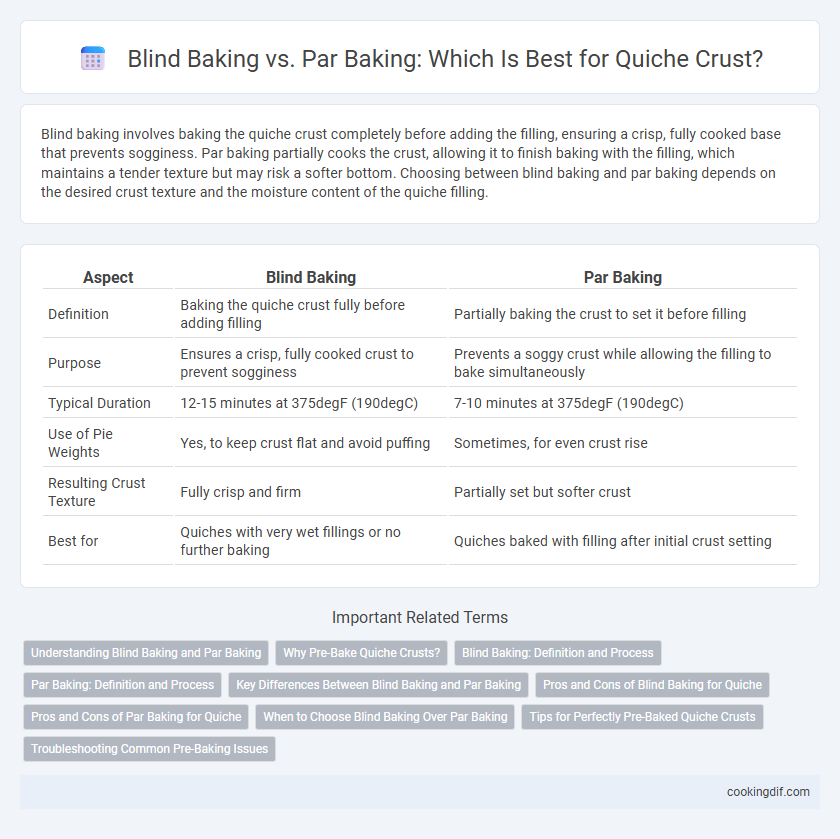Blind baking involves baking the quiche crust completely before adding the filling, ensuring a crisp, fully cooked base that prevents sogginess. Par baking partially cooks the crust, allowing it to finish baking with the filling, which maintains a tender texture but may risk a softer bottom. Choosing between blind baking and par baking depends on the desired crust texture and the moisture content of the quiche filling.
Table of Comparison
| Aspect | Blind Baking | Par Baking |
|---|---|---|
| Definition | Baking the quiche crust fully before adding filling | Partially baking the crust to set it before filling |
| Purpose | Ensures a crisp, fully cooked crust to prevent sogginess | Prevents a soggy crust while allowing the filling to bake simultaneously |
| Typical Duration | 12-15 minutes at 375degF (190degC) | 7-10 minutes at 375degF (190degC) |
| Use of Pie Weights | Yes, to keep crust flat and avoid puffing | Sometimes, for even crust rise |
| Resulting Crust Texture | Fully crisp and firm | Partially set but softer crust |
| Best for | Quiches with very wet fillings or no further baking | Quiches baked with filling after initial crust setting |
Understanding Blind Baking and Par Baking
Blind baking involves baking the quiche crust without any filling to ensure it stays crisp and doesn't become soggy, often using pie weights or dried beans to prevent puffing. Par baking partially cooks the crust before adding the filling, allowing it to finish baking together with the quiche to maintain a tender yet firm texture. Both techniques are essential for achieving a perfectly baked quiche crust, preventing a soggy bottom and ensuring even cooking.
Why Pre-Bake Quiche Crusts?
Pre-baking quiche crusts ensures a crisp, non-soggy base that holds up against the wet custard filling, preventing a mushy texture. Blind baking, done by baking the crust alone with pie weights, sets the crust structure fully before filling, ideal for recipes requiring longer baking times. Par baking partially cooks the crust, providing a firm foundation while allowing final baking with the filling to achieve perfect flakiness and prevent overcooking.
Blind Baking: Definition and Process
Blind baking refers to the process of pre-baking a quiche crust without the filling to prevent sogginess and ensure a crisp texture. This technique involves lining the crust with parchment paper or aluminum foil before filling it with pie weights, dried beans, or rice to maintain its shape during baking. Typically, the crust is baked at 375degF (190degC) for 15-20 minutes until firm and lightly golden before adding the quiche filling.
Par Baking: Definition and Process
Par baking a quiche crust involves partially baking the pastry before adding the filling, ensuring a crisp and stable base that prevents sogginess. The process includes rolling out the dough, fitting it into the pie dish, then baking it at a moderate temperature, often with pie weights or beans to maintain shape. This technique allows the crust to set without fully browning, creating an ideal texture for quiche fillings.
Key Differences Between Blind Baking and Par Baking
Blind baking involves fully baking the quiche crust without any filling, ensuring a crisp and fully cooked base that prevents sogginess. Par baking partially cooks the crust, leaving it slightly underdone so it can finish baking with the filling, which helps achieve a tender yet firm texture. The key difference lies in the baking completion: blind baking is completed before adding filling, while par baking requires additional baking time with the filling inside.
Pros and Cons of Blind Baking for Quiche
Blind baking quiche crust ensures a crisp, fully cooked base that prevents sogginess caused by the custard filling. This method avoids shrinkage and bubbling, providing a sturdy, golden foundation ideal for delicate fillings. However, blind baking adds an extra step and time, and if not properly weighed down, the crust may puff up or become too dry.
Pros and Cons of Par Baking for Quiche
Par baking quiche crust partially cooks the dough, preventing sogginess and ensuring a crisp bottom crust by setting the structure before adding the filling. This method reduces the risk of undercooked crust but requires careful timing to avoid overbaking and drying out the pastry. Par baking offers a balance between texture and convenience, though it may result in a slightly less tender crust compared to blind baking.
When to Choose Blind Baking Over Par Baking
Blind baking is preferred for quiche crusts when the filling is very moist or custard-based, ensuring the crust remains crisp and fully cooked without becoming soggy. Use blind baking when the recipe requires no further baking after adding the filling or when a firm, golden crust is essential for texture contrast. Par baking suits quiches with fillings that need additional baking time, but blind baking is essential for preventing a soggy bottom in delicate quiche preparations.
Tips for Perfectly Pre-Baked Quiche Crusts
Blind baking a quiche crust involves baking it fully with pie weights until golden brown, preventing sogginess by ensuring a crisp base. Par baking partially cooks the crust to set it, allowing for a tender yet sturdy texture ideal for quiche fillings that require further baking. To achieve a perfectly pre-baked quiche crust, chill the dough thoroughly before baking, use parchment paper with pie weights or dried beans to maintain shape, and prick the crust with a fork to avoid air bubbles.
Troubleshooting Common Pre-Baking Issues
Blind baking involves baking the quiche crust fully before adding the filling, preventing sogginess and ensuring a crisp base, while par baking only partially cooks the crust, which helps avoid overbaking during final cooking. Common issues like shrinking or bubbling can be addressed by using pie weights and properly chilling the dough before blind baking. To troubleshoot, dock the crust with a fork and line it with parchment paper to maintain shape and promote even baking for a flawless quiche crust.
Blind baking vs par baking for quiche crust Infographic

 cookingdif.com
cookingdif.com